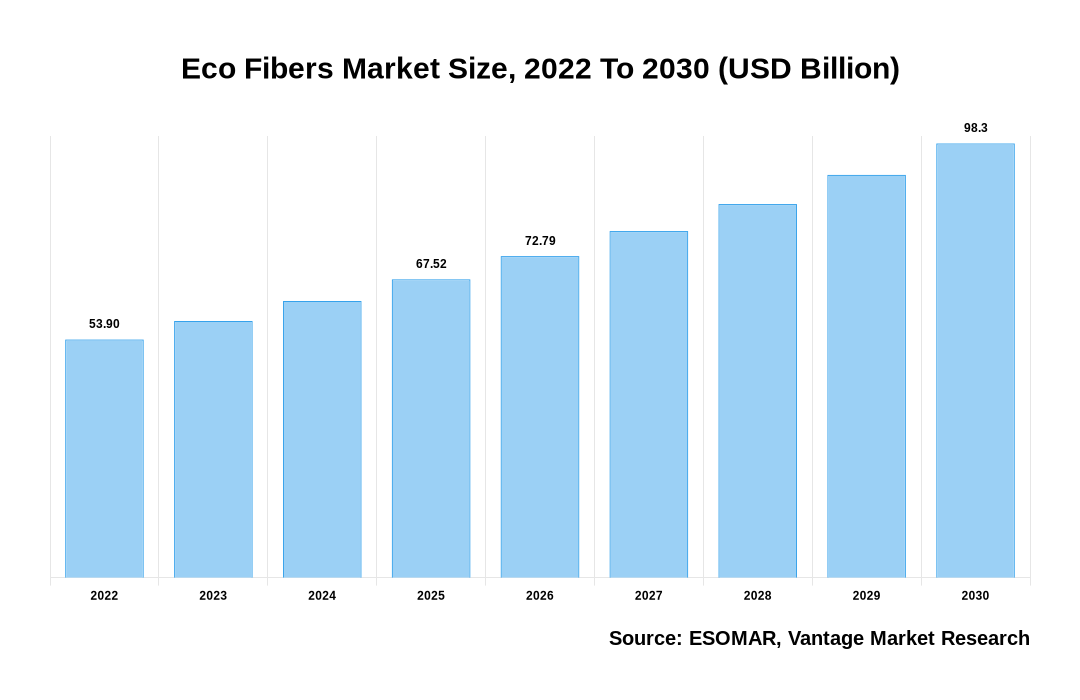Global Eco Fibers Market
As stated in our extensive report; the Global Eco Fibers Market accounted for USD 50.8 Billion in the year 2021.
Over the course of the forecast period, the market is expected to develop as a result of growing worries about the negative effects that utilizing synthetic fibers has on the environment. Designer clothing and apparel are increasingly using Eco Fibers. Over the forecast period, technological developments in the creation of eco-fiber textiles with antimicrobial, hypoallergenic, insulating, UV-resistant, highly breathable, and absorbent properties are anticipated to increase their significance in the apparel market. As the textile enterprises in the nation concentrate on creating efficient work processes, restructuring their operations, and investing in specialty products and markets, the market in the United States is anticipated to experience significant expansion. This has turned out to be helpful for the industry’s expansion.

Click To Get a Free Sample On the Research Study
Key factors influencing Eco Fibers Market Growth
The growth of the global Eco Fibers market can be attributable to the following:
- The enormous amount of fabric waste generated by rising fashion has sped up the development of fiber technologies to make more environmentally friendly fibers. This is anticipated to lessen the environmental impact and open up new market expansion prospects.
- Most natural fibers are comfortable and can be found for less money, which causes a high demand for the product.
- In industrialized and developing countries, cotton is a common natural fiber utilized in various end-use industries. Additionally, there is a growing tendency in manufacturers to make efforts to find alternative material sources that could be safer for the environment and more practical for customer use.
- To have a more sustainable impact on the fashion business, fashion brands are also implementing improvements in the supply chain and choosing eco-friendly fibers. This industry has significant potential thanks to the growing trend of using less synthetic fiber.
- The textile/apparel, automotive, and medical industries are all expanding faster than the fashion industry. The consumption of these Fibers is rising due to the expansion of these industries.
- The market is driven by emerging economies such as those in Southeast Asia, South Africa, China, and India. Due to the high levels of disposable money in these developing countries, the demand for clothing and home furnishings is increasing.
- Additionally, as the population grows, consumer demand for more homes, cars, and clothes increases. As a result, the demand for the product will increase as the fabric is increasingly used for a variety of purposes, including interior design, covering, and furnishing.
- The epidemic also compelled developing nations to employ Eco Fibers in medicinal applications. The elements promoting market expansion are lowering the risk of infection and upholding personal hygiene in order to satisfy customer demand during the pandemic.
- However, the market restrainers are high costs for Eco Fibers and the low cost of replacements. The cost of cultivating and producing the product adds significantly to the high cost of Eco Fibers.
- A bigger movement toward synthetic fibers is also being brought about by cheaper alternatives like synthetic fiber, which includes rayon, polyester, and nylon. Furthermore, synthetic fibers are simple to produce, refine, and use for most applications, which impacts the usage of this fiber. Together, these elements are limiting market expansion.
Asia Pacific Region to Lead the Market
Asia Pacific Eco Fibers market is getting more significant with maximum market share during the forecast period. Due to its rapid economic expansion, aided by its growing population, the region represented the biggest value on the world market. The increase in demand for fiber from garments and industrial applications is driving the market in the region. Industries, including textile, automotive, and construction, are expanding, driving product consumption. The market in North America is primarily driven by the medical sector, which is helped by technical advancements that allow for the environmentally friendly disposal of medical waste. The area’s market is driven by efforts to reduce medical waste and create more sustainable products. Manufacturing automobiles, which use fabrics for the interior, handle covers, lining, and seat covers, increased throughout Europe. The expanding automobile industry mostly drives the use of fiber and the European market.
Conclusion
Growing worries about the negative effects of utilizing synthetic fibers positively influence the overall Eco Fibers market.
Some of the key players in the Global Eco Fibers Market include- Lenzing AG (Austria), US Fibers (US), Polyfibre Industries (India), Grasim Industries Ltd (India), Wellman Advanced Materials (US), Shanghai Tenbro Bamboo Textile Co. Ltd. (China), China Bambro Textile (Group) Co. Ltd. (China) and others.
![[Market Research Reports] – Research Google News Blog | VMR.Biz](https://www.vmr.biz/wp-content/uploads/2022/12/logo-removebg-preview.png)











